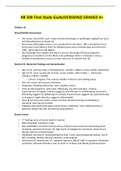NR 509 Final Study Guide(VERSION2) GRADED A+
Chapter 10
Breast/Axillae Assessment
• Any lumps, discomfort, pain- lumps may be physiologic or pathologic ranging from cysts
and fibroadenomas to breast CA
• Breast pain (Mastalgia) alone is not considered CA risk factor. CBE is warranted. Focal
breast pain more likely to merit DI. Medical issues assoc w breast pain are hormones,
SSRIs, spironolactone and digoxin
• Any discharge from nipples and when it occurs? Discharge of fluid unrelated to
pregnancy or lactation is more likely to be pathologic when it is bloody or serous,
unilateral, spontaneous, assoc w a mass and occur in women over 40
Normal VS. Abnormal Findings and Interpretation
• Age 15-25- common mass is fibroadenoma- smooth, rubbery, round, mobile. Nontender
• Age 25-50- cysts- usually soft to form, round, mobile, often tender o Fibrocystic
changes- nodular, ropelike
o Cancer- irregular, firm, may be mobile or fixed to surrounding tissue
• Over 50- cancer until proven otherwise
• Pregnancy- lactating adenomas, cysts, mastitis, cancer
• Arms at side inspection- note color, thickening, size and symmetry, contour,
characteristics of nipple. (redness suggests local infection or inflammatory carcinoma,
thickening suggest CA, flattening of normally convex breast suggests CA, asymmetry due
to change in nipple direction suggests CA(inverted)).
• Have pt put arms over head, on hips and lean forward to bring out dimpling or
retraction that may be invisible
• Palpation best performed when breast tissue is flattened- from midsternal line to
posterior axillary line into tail (vertical strip pattern)
Breast Cancer
• 2nd leading cause of cancer death in women
• Most important risk factor is age
• Non modifiable risk factors family history of breast and ovarian CA, inherited genetic
mutations, personal hx breast CA, high levels of endogenous hormones, breast tissue
density, lesions on breast biopsy
• Modifiable risk factors- breastfeeding less than 1 year, postmenopausal obesity, use of
HRT, smoking, alcohol, physical inactivity, contraception
• Risk factors for male breast CA- radiation exposure, BRCA1 AND 2 mutations, Klinefelter
syndrome, testicular disorders, fam hx, etoh or cirrhosis and obesity Gail and Claus
, model estimate absolute lifetime risk of breast CA Gail-incorporates age, race, 1st
degree relatives w breast ca, previous biopsies, hyperplasia, age of period, age 1st
delivery. Shouldn’t be used to women w hx breast CA or radiation exposure or those
under 35.
• Claus- incorportates family hx male and female, age
• Also ask about fam hx ovarian CA
• Screening recommendations
Mammogram CBE BSE
US Preventative 50-74-biennially >40 not enough Recommends
Services <50 based on pt evidence to assess against
teaching specific factors harm or benefit of BSE CBE
American CA 40-45 optional Not recommended Not recommended
Society annual
45-54-annual
>55-biennial
American college >40 annually 20-39 every 1-3 yrs Encourage BSE
of OBGYN >40 annually
• Mammogram- low sensitivity and specificity- high false positives. Perform better in
younger women and with higher breast density
Self-Breast Examination
Because breasts tend to swell and become more nodular before menses from increasing
estrogen stimulation, the best time for examination is 5 to 7 days after the onset of
menstruation
Chapter 11 and Chapter 15 Abdominal/Peritoneal/Rectal Assessment and Modification for
Age
Abdominal assessment:
Sequence: Inspection, auscultation, percussion, palpation
Auscultation: for bowel sounds, bruit, and friction rub. Possible abnormal sounds: increased or
decreased motility, bruit of renal artery stenosis, liver tumor, splenic infarct. .
Percuss the abdomen for patterns of tympany and dullness. Possible abnormalities: Ascites, GI
obstruction, pregnant uterus, ovarian tumor
Palpate all quadrants of the abdomen for abdominal tenderness. Light palpation for guarding,
rebound, and tenderness. Possible abnormalities: Firm, board like abdominal wall—
suggests peritoneal inflammation. Guarding if the patient flinches, grimaces, or reports
, pain during palpation. Rebound tenderness from peritoneal inflammation; pain is
greater
when you withdraw your hand than when you press down. Press slowly on a tender
area, then quickly “let go. If you feel a mass, examine with the abdominal muscles
tensed, usually, abdominal wall masses can be observed, whereas intra-abdominal
masses are more concerning.
A left upper quadrant mass is more likely to be a kidney if there is no palpable “notch,” you can
push your fingers between the mass and the costal margin, there is normal tympany
over this area, and you cannot push your fingers medial and deep to the mass
Rectal assessment: Rectal assessment is a part of regular GI assessment over age of 40.
Inspection: Check for fissures, lesions, scars, inflammation, discharge, rectal prolapse, skin tags,
and external hemorrhoids.
Palpation: The rectal walls should feel soft and smooth, without masses, fecal impaction, or
tenderness.
Peritoneal assessment:
Check for ascites, a large accumulation of fluid in the peritoneal cavity caused by advanced liver
disease, heart failure, pancreatitis, or cancer.
Do not palpate a rigid abdomen. Peritoneal inflammation may be present, in which case
palpation could cause pain or rupture an inflamed organ
Normal VS. Abnormal Findings and Interpretation
• Visceral pain- occurs when hollow abd organs are distended or stretched- in RUQ
suggests liver distention




